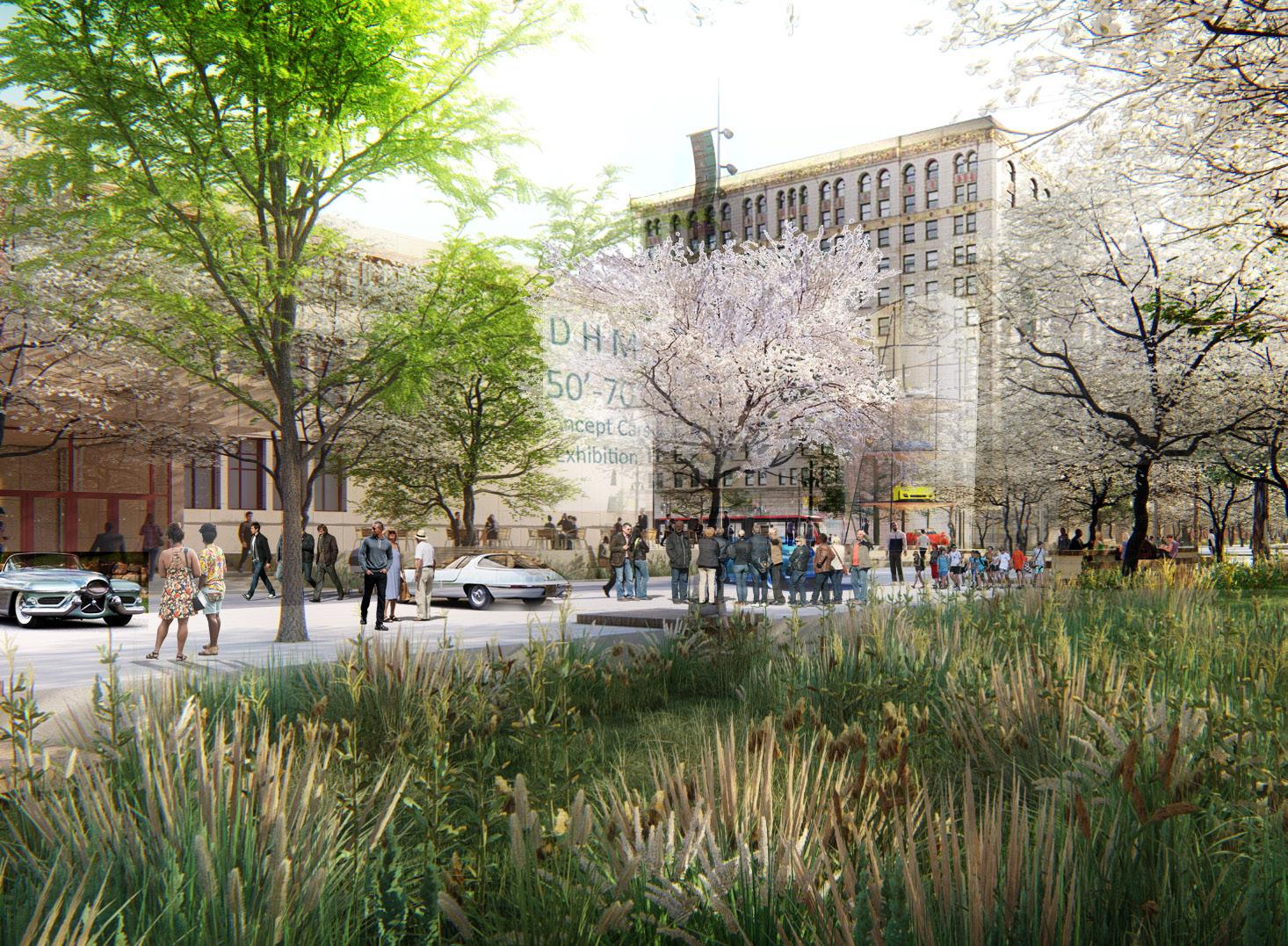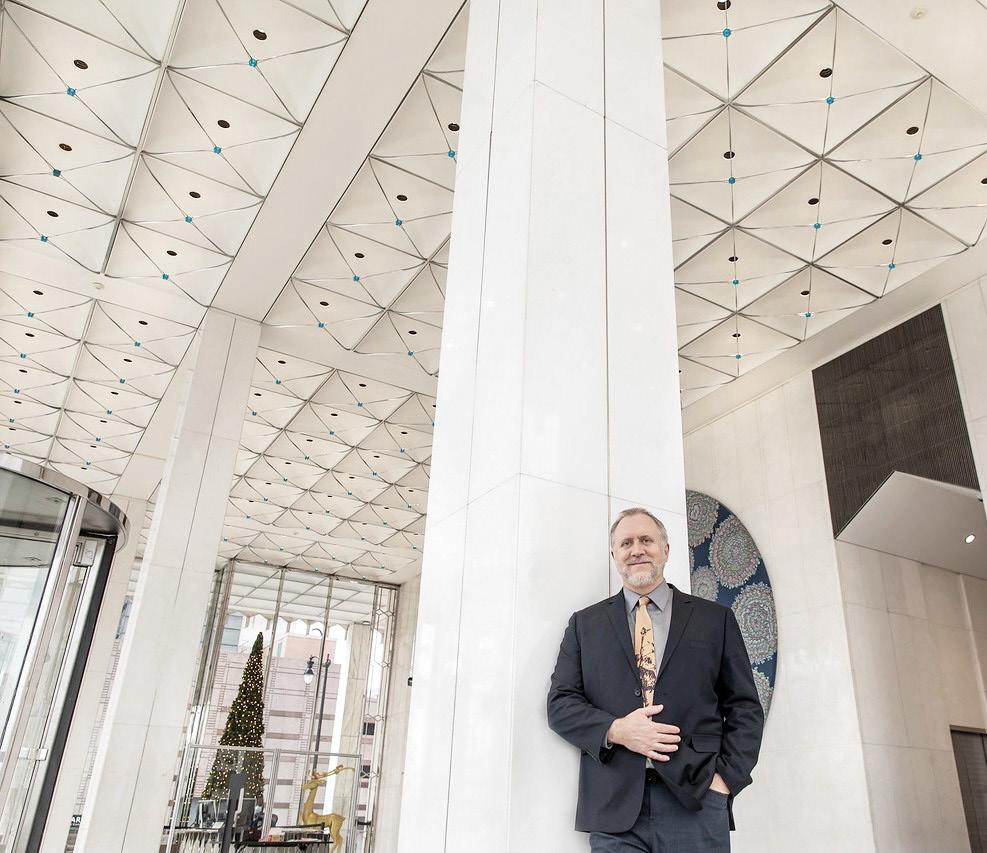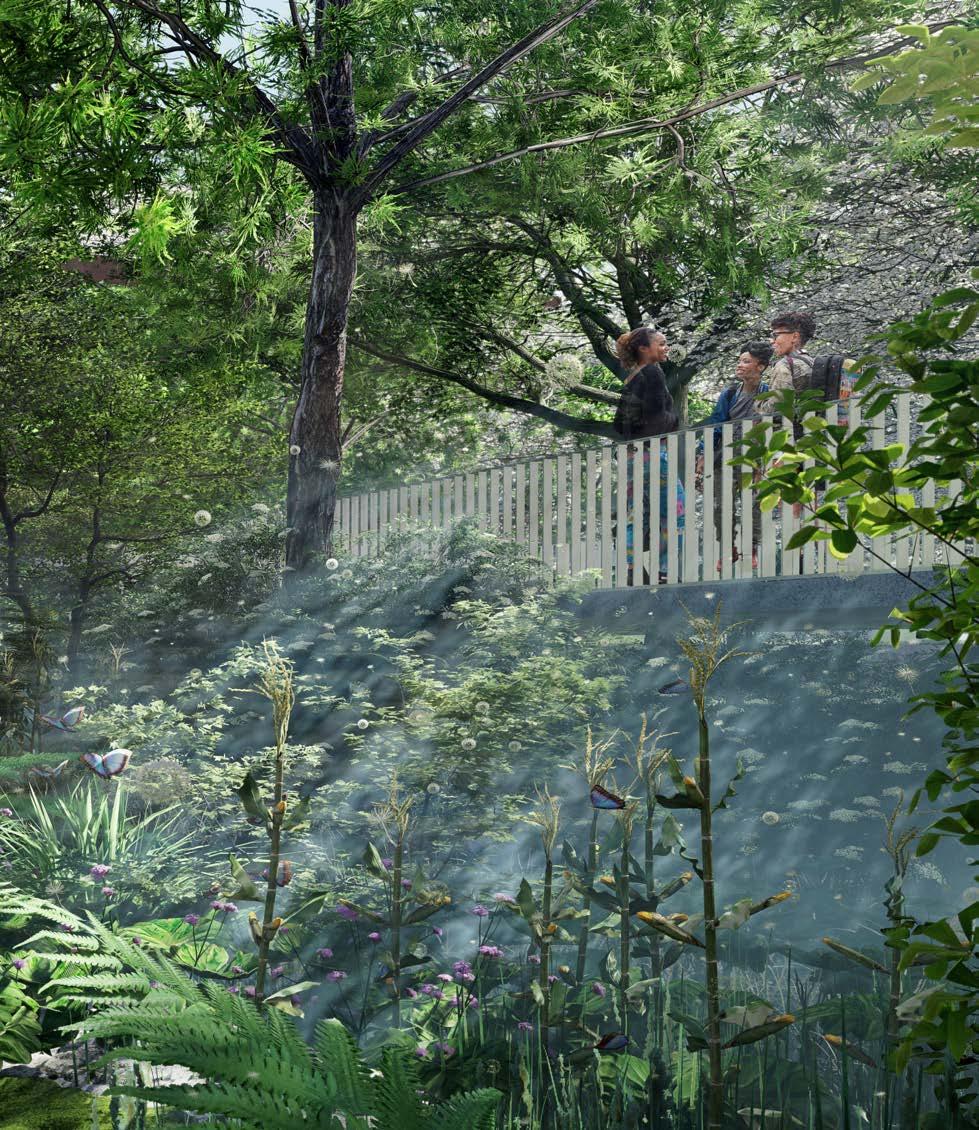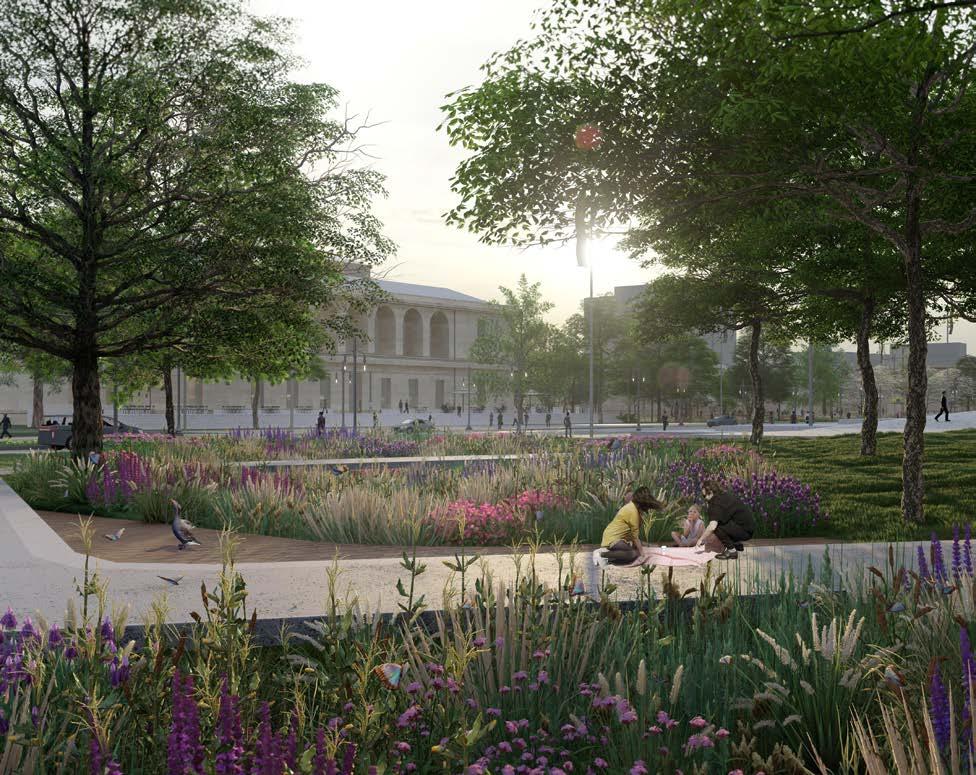
14 minute read
Environmental Regeneration
from Detroit Cultural Center V1
by Akoaki
3
Environmental Regeneration
Advertisement
The paradox of infrastructure is that it requires significant investment, while typically going unseen. CCPI’s approach to water management is founded on a different philosophy: infrastructure can be beautiful and visible. By incorporating runoff mitigation, drainage, and filtration into bio-dynamic landscapes, the investment in water management will become an investment in the living ground of the city and an enhancement of the urban experience.
In addition to being a tactical and cost-efficient approach to infrastructural remediation, the plan will offer greater biodiversity and will buffer the impact of climate change in the city by reducing the heat island effect. The design models environmentally just and ecologically salient solutions that directly address pressing challenges in the built environment.
Weathering The Storm
The City of Detroit is located in the Southern Great Lakes Forest ecoregion—one of the most heavily impacted regions due to human activity on the continent, according to the World Wildlife Fund. As the average annual precipitation in the region increases and extreme storms occur more frequently, it is imperative that existing and future urban developments in Detroit implement various forms of Green Stormwater Infrastructure (GSIs). Everyone in the city of Detroit—and the entire Great Lakes watershed region— will benefit from this project’s green infrastructure. By transforming 16 acres of paved surface into lush landscape, the District will become an ecosystem responsive to climatechange vulnerabilities. The plan is designed to collect and manage 15.5 million gallons of runoff annually, alleviating sewage overflow during rainfall events.
The average yearly temperature in the Great Lakes basin increased by 1.6 degrees Fahrenheit from 19802016, while the average temperature change within the United States was just 1.2 degrees Fahrenheit. Projections for annually-averaged temperatures show an increase of 5.810.1 degrees Fahrenheit by the end of the 21st century, depending on future greenhouse gas emissions. A warmer atmosphere is able to hold more moisture, causing an increase in the intensity and frequency of wet weather events. Until now, this increase in wet weather has arrived in the form of unusually large events. Moving forward, these events will re-distribute across the seasons. Overall, the Great Lakes Region can expect to see wetter winters and springs while summer precipitation decreases by 5-15%. In areas with impervious surface area, these events are expected to cause more frequent flooding and damage homes, roadways, and other infrastructure. This will also place a greater amount of stress on stormwater handling systems, overloading water treatment infrastructure, and polluting water sources.
Modern cities often use an excessive amount of impervious surfaces, a trend designed to expedite progress. Contemporary times have taught us otherwise. It is now our responsibility to remediate and reimagine past efforts so that future generations can thrive. “
Olivier Philippe Principal, Agence Ter
Water management infrastructure is fully integrated into the landscape and provides opportunities for institutions such as the Detroit Historical Museum - pictured here - to enjoy an ecologically functioning and beautiful design as they take their programming outdoors.
OAKWOOD-NORTHWEST INTERCEPTOR [ONWI] NORTH INTERCEPTOR EAST ARM [NIEA] DETROIT RIVER INTERCEPTOR [DRI]
Midtown Cultural Center
CSO LOCATIONS
WATER SUPPLY INTAKES
SEWER LINES (COMBINED SYSTEM)
SEWER INTERCEPTOR LINES
¹ “Detroit WWTP NPDES Fact Sheet - State of Michigan.” Detroit Water and Sewage Department.
Waste Water Treatment Facility
In Detroit
Combined Sewer Overflows (CSOs) are points where the contents of a combined sewer system overflow occasionally and discharge excess wastewater directly to nearby streams, rivers, or other water bodies. These overflows contain not only storm water but also untreated human and industrial waste, toxic materials, and debris.
Stormwater runoff from impervious areas is a major cause of water pollution in urban areas. In Detroit, it is most notably the cause of combined sewer overflow released into the Rouge or Detroit Rivers. However, even in separated sewer areas (where the sanitary and stormwater systems are not combined), stormwater runoff carries trash, bacteria, and heavy metals into our natural waterways. In addition, peak discharges from heavy rains cause flooding in urban neighborhoods that damage stream habitat, property, and infrastructure.
It is clear that capturing and treating stormwater runoff is critical for all urban areas and not just those serviced by a combined sewer. Green stormwater infrastructure uses vegetation, enhanced soils, water harvesting/reuse, and other elements to mimic natural processes such as infiltration and evapotranspiration to reduce runoff. This lessens the demand on existing “gray” infrastructure (conventional concrete pipes and wastewater treatment facilities) but also creates healthier urban environments by improving air quality and beautifying the neighborhood. Green stormwater infrastructure includes: bioretention cells, bioswales, vegetated roofs, cisterns, permeable pavement, constructed wetlands, among others. Another reason to integrate green stormwater infrastructure into urban environments is to improve resiliency. Climate change has caused an increase in extreme weather events and also caused urban temperatures to rise. Green stormwater infrastructure is effective at diminishing increased rainfall intensities while mitigating the urban heat island effect. Promoting the integration of green stormwater infrastructure in urban environments will improve the health and welfare of all Detroit residents.
Untreated combined sewer overflow coming from the City of Detroit and surrounding communities average 1-3 billion gallons per year. 95% of total runoff is caused by weather events with less than 1” of rain.
The current Cultural District footprint is 40% impervious.
In Conversation With Dan Rieden

Dan Rieden is a Lead Landscape Architect at the City of Detroit Planning and Development Department. A self-directed, innovative urbanist, Dan has been a bridge between the City of Detroit and the CCPI Initiative from the project’s inception. He brings deep and resonant expertise in master planning, landscape ecology, and site design coupled with a genuine consideration of Detroit neighborhoods and communities. We connected with Dan to discuss his contributions to the project and his penchant for catalyzing and sustaining creative collaborations.
Sarah Carter (SC): Let’s talk about your role as lead landscape architect for the City of Detroit.
Dan Rieden (DR): To serve the City of Detroit is a great honor. I believe my role is centered on listening and delivering access for the residents of Detroit to be heard. Detroiters told us that they want to see a cultural center that is welcoming to all; embraces opportunities to be represented and celebrated within the programming of the cultural center; and allows all ages access to a place that feels safe, inviting, and easy to navigate from institution to institution. Detroit has world-class, rich cultural resources in its museums, libraries, and universities. They have a wonderful opportunity to coordinate their efforts, open their doors to the public spaces outside, and co-create more interaction between public and private spaces that allows more synergy in this public square. So the role of a landscape architect is that of bridge-builder: to facilitate a dialogue between the public and private, and between professions - architects, engineers, planners – to bring this discussion into reality such as those ideas we are generating around the Cultural Center Planning Initiative (CCPI).
Landscape architects are also responsible for creating boundaries around scope creep, or the physical boundaries of a space. Regarding the initial discussion of the boundaries of the CCPI, our department believed that we should delineate a space large enough to be visionary yet tight enough in its scope to have real impact. By staying within the immediate collection of institutions in this area, potential solutions can be represented and extended outward.
Landscape is physically the space between these institutions, but, professionally, landscape architecture can be the facilitator for all these different disciplines to come together and discuss. We’re trained as landscape architects to talk between the lens of science and art. How can we address hydrology? How can we address systems of civic space? How can we design streetscapes, circulation, and all the interaction between different urban layers? What are the different elements of analysis that go into the design of this type of space? Landscape is everything visible on the surface of our built environment and extends down into invisible systems below grade.
What is the city’s responsibility in the context of a project like this?
We envision the City acting as a guide throughout this process. I see the City as responsible for creating a space to have productive discussions. We do not want to get our hands into the project too much, but we do want to help establish boundaries. Unfortunately, we have limitations on resources. Staffing and budget are vying for attention while the city is dealing with COVID and other concerns that Detroit communities have.
That said, we understand the value of CCPI’s longevity and its impact. The City has helped to set the geographic boundaries of the space and guidance on the conversation itself. We need to be mindful of the context that we’re working in at this point of history in the city. We also need to be mindful of the strong feedback we have gotten from communities. People are interested in how we are creating more accessibility in the context of the pandemic and how we are addressing drainage issues in the district and beyond. The City is helping to make sure this project is connecting with the public, and, as design moves forward, we’re not isolating ourselves from the pressing concerns of today.
This project aims to combine cultural and recreational spaces with water management infrastructure. It offers outdoor public spaces that have proven to be so crucial during the recent pandemic. Does this project feel timely? Ambitious? Relevant?
Absolutely! We have to ask ourselves why is this project different? Why is this unique? I think the timing of COVID, in some ways, has been instructional. COVID has taught us how to bring indoor spaces outside in a very efficient way, right? For example, how can we create social spaces outside that are safe? That’s a good thing, and it’s right in line with the mission of this design. If I could, I would like to step back a minute and talk about the history of this context. Detroit, for years, has had a history of insulating itself. As we’ve had population drain from the city our resources have dropped. Ultimately, with the bankruptcy, a lot of institutions and communities have had to fend for themselves. These circumstances created a condition of fortification, if you will. This mode of insular thinking is visible in the architecture and design of the district’s buildings. Today, Detroit is in a more optimistic time - we can take the bars off the windows, take the fences down, open up ourselves to the neighborhoods, and create a more inclusive space for our institutions. These institutions are starting not to think of themselves as isolated, but really to think of themselves as a collective. This shift is so important to Detroit as a whole. Thinking of ourselves collectively is how we put ourselves on the map as a city.
So getting back to your question - what’s different about this project? The way the design team handles the social context. The integration of the city’s social fabric into all aspects of the design is truly unique. Integrating the cultural and material reality of place into the design process ensures a more inclusive, more open, and more compelling collective future.
CCPI focuses on making the common space around and between the institutions more desirable, safe, well lit, and technologically enabled. The plan offers a series of welcoming thresholds for all of the institutions with the potential for cross pollination, shared audiences, and the creation of a sense of belonging.
Exactly. I think another unique layer that this design team has introduced - as a potential model for the city - is lighting. The lighting design is phenomenal. It ties in really well with the idea of social fabric we talked about while considering seasonality and time of the day. Detroit gets fairly dark for four or five months of the year, and people tend to avoid being outside. This plan introduces an everyday potential experience where people can feel safe coming to the district. It’s not always about blaring bright lights but creating an atmosphere of interest.
Earlier you talked a little bit about being a bridge builder, and I wonder if you would like to go into any more detail about what it means to create a space or a project in partnership with civic and private institutions. Also, how
do we balance the interests of funders, stakeholders, end users, and the city?
I think one of the big successes that we can celebrate today is this collective conversation that we’re having with all these institutions. This is the first time all these institutions have really worked together on one vision, and that’s a huge accomplishment. The city can play a role in bringing this conversation to an even larger audience and encouraging the networks within each of these institutions to share their experiences nationally and internationally outwardly.
I also appreciate that the design team has looked at not only the potential impacts, but the potential cost savings for the City. The stormwater management proposal for this plan is right on point with what the City of Detroit is looking for, and it’s timely as we explore other potential opportunities to handle stormwater in light of climate change.
With national resources potentially aligned, this project feels timely.
The strategic thinking behind green stormwater infrastructure is crucial in this proposal. With recent flooding events wreaking havoc, Detroit residents are now seeing the importance of water management. This project, in particular, illustrates how a landscape designed to mitigate damaging overflow events can also be beautiful and inviting. The design offers a functional biodiverse solution right in the heart of the city. I can already imagine the lush gardens hosting birds and butterflies that make a more enjoyable outdoor environment.
Anything we’ve missed?
There’s so much to celebrate. We finally have a vision that I think is very strong and it touches on so many layers: stormwater, streetscape, cultural programming, pedestrian safety, architectural plugins, inclusivity, and access. We also need to celebrate the success of the institutions. They have a shared goal, and they are already modeling ways to share resources for operations.
I always say you may leave Detroit, but Detroit will never leave you. There’s something about the city that has a bit of soul and will always stay with you, no matter what you do. I really feel that this team has done such a superb job. The design team came out of a large international selection, and has really made significant contributions to this collective vision.

Proposed ‘Climate Machine’ garden for the Michigan Science Center transforms an above-ground parking lot into an immersive bio-diverse learning environment.
Cooling Oasis
Beyond stormwater infrastructure, the plan increases the tree canopy by 60%. The introduction of a denser planting strategy reduces temperatures in the district by up to 7 degrees, illustrating how cities can adopt a more resilient climate change strategy.
The plan is designed to sponsor a range of landscape conditions with both wet and dry environments. Efficient drainage is engineered into the elements, ensuring the mitigation of swampy patches or boggy fields and control over flora and fauna. The Square’s levee design creates efficiently draining micro-wetlands and a multi-level natural environment that is easy to maintain. The landscape is designed to accommodate a variety of ground conditions, native plants, and inviting environments for visitors to occupy.
The Science Center Garden educates about micro-climates by demonstrating how water cycles, atmosphere, and ecosystem design work at the scale of the project and the planet. Here, the science behind the project merges seamlessly with exhibitions and inhabitable environments. In this instance, a parking lot is transformed into a climate machine that serves to change paradigms about landscape in the city.
Green stormwater infrastructure has clear applications when handling runoff. We sometimes forget all of the secondary benefits that help alleviate and temper our urban environments. “
Don Carpenter Principal, Drummond Carpenter, PLLC
The Role of the Ecotone
The Ecotone inserts a native, biodiverse landscape into the heart of Detroit. This introduction of a resilient ecological system will filter urban runoff, slow the flow of stormwater, temper the warming effect of development and improve local air quality. In the process, the Ecotone will serve as home to resilient vegetation while helping accommodate and introduce local and migratory wildlife species. For residents and visitors, this landscape element will produce spaces for passive recreation, environmental education, and respite.
This strategy plugs into the Southern Great Lakes Forest ecoregion, which includes sweeping interior wetlands, major staging areas for migrating birds, and sand pits hosting unique plant communities. This region serves as an extension of the Midwestern prairies. Agricultural and urban development are the predominant land uses here. Remaining patches of wildlife have been diminished significantly with little to no connectivity in many areas. In many areas, this region has no protected areas larger than 500 square kilometers. Given the region’s ecological challenges, our watershed impact is all the more critical. The Huron-Erie Corridor, including Lake St. Clair, the St. Clair River, and the Detroit River, makes various contributions to the overall health of Lake Erie. This corridor contains near shore, stream, and extensive coastal wetland habitats (the Detroit River has over 4,000 acres). More than 65 species of fish, 16 of which are threatened or endangered, use the Huron-Erie Corridor. This area is also part of the central Great Lakes flyway for millions of migratory birds.
The Ecotone is designed to offset the impacts of urbanization and human activity while making space for humans and non-humans to coexist in the city.
Don Carpenter Principal, Drummond Carpenter

The Necklace creates a new way to experience the grounds of the Detroit Institute of Arts.




